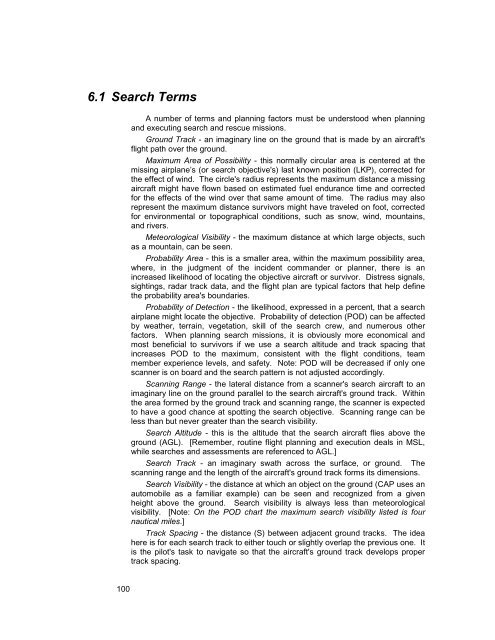MART Vol. II MO/MP - NESA - Civil Air Patrol
MART Vol. II MO/MP - NESA - Civil Air Patrol
MART Vol. II MO/MP - NESA - Civil Air Patrol
Create successful ePaper yourself
Turn your PDF publications into a flip-book with our unique Google optimized e-Paper software.
6.1 Search TermsA number of terms and planning factors must be understood when planningand executing search and rescue missions.Ground Track - an imaginary line on the ground that is made by an aircraft'sflight path over the ground.Maximum Area of Possibility - this normally circular area is centered at themissing airplane’s (or search objective's) last known position (LKP), corrected forthe effect of wind. The circle's radius represents the maximum distance a missingaircraft might have flown based on estimated fuel endurance time and correctedfor the effects of the wind over that same amount of time. The radius may alsorepresent the maximum distance survivors might have traveled on foot, correctedfor environmental or topographical conditions, such as snow, wind, mountains,and rivers.Meteorological Visibility - the maximum distance at which large objects, suchas a mountain, can be seen.Probability Area - this is a smaller area, within the maximum possibility area,where, in the judgment of the incident commander or planner, there is anincreased likelihood of locating the objective aircraft or survivor. Distress signals,sightings, radar track data, and the flight plan are typical factors that help definethe probability area's boundaries.Probability of Detection - the likelihood, expressed in a percent, that a searchairplane might locate the objective. Probability of detection (POD) can be affectedby weather, terrain, vegetation, skill of the search crew, and numerous otherfactors. When planning search missions, it is obviously more economical andmost beneficial to survivors if we use a search altitude and track spacing thatincreases POD to the maximum, consistent with the flight conditions, teammember experience levels, and safety. Note: POD will be decreased if only onescanner is on board and the search pattern is not adjusted accordingly.Scanning Range - the lateral distance from a scanner's search aircraft to animaginary line on the ground parallel to the search aircraft's ground track. Withinthe area formed by the ground track and scanning range, the scanner is expectedto have a good chance at spotting the search objective. Scanning range can beless than but never greater than the search visibility.Search Altitude - this is the altitude that the search aircraft flies above theground (AGL). [Remember, routine flight planning and execution deals in MSL,while searches and assessments are referenced to AGL.]Search Track - an imaginary swath across the surface, or ground. Thescanning range and the length of the aircraft's ground track forms its dimensions.Search Visibility - the distance at which an object on the ground (CAP uses anautomobile as a familiar example) can be seen and recognized from a givenheight above the ground. Search visibility is always less than meteorologicalvisibility. [Note: On the POD chart the maximum search visibility listed is fournautical miles.]Track Spacing - the distance (S) between adjacent ground tracks. The ideahere is for each search track to either touch or slightly overlap the previous one. Itis the pilot's task to navigate so that the aircraft's ground track develops propertrack spacing.100














